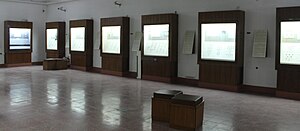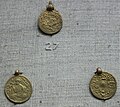Indian National Museum (Galleries) Part - II (Last):
Decorative Arts Gallery
Decorative Arts refer to Arts concerned with the design and decoration of objects that are prized for their utility, rather than for their purely aesthetic qualities. Ceramics, Pottery,Furniture, Textiles, Glassware, Metalware andJewellery are all included under Decorative Arts. The Decorative Arts section is also divided into 2 galleries.
Decorative Arts Gallery 1
This gallery gives a glimpses of three collections of the Museum - Ivory, Jade and Ceramics. The Ivory group has several Hindu and Christian religious figures. The Jade section showcases the utilitarian objects, while the glazed tiles and blue-white pottery are in the Ceramic group. The Gallery also has two interesting themes – Thrones of India, and Games and Leisure in the Past. The theme of thrones shows the evolution of the seat of power. From the low flat seats of antiquity to the modern armed chair, the journey of the throne is a fascinating story. An intricately carved Home Shrine and some metal Hindu and Jain pitikas (small seats for keeping idols for home shrines) are also present. The Jewel studded throne of the King of Varanasi is one of the best example to show Power. The Games section has Rattles, Yo-Yo, Gamesman of Chess and Chaupar. Tops made of different materials with different designs are also exhibited. These artefacts combine the aesthetic and artistic elements to everyday objects used for games.
Decorative Arts Gallery 2
This gallery has artefacts from the proto-historic period to the present day. The variety, quality and media did increase with the taste and status of different generations and the process is on even today. This gallery exhibits Metalware, Jewellery and Wooden objects. Most notable among the wooden objects are the Vahana on display.
Miniature Paintings Gallery
The Museum has over 17,000 miniature paintings. The gallery is divided according to the places and time where the schools of arts flourished. The paintings show the rich heritage of Indian Miniature Paintings. These paintings belong to major styles such asMughal, Deccani, Central India, Rajasthani, Pahari and many sub-styles relating to the period from 1000 CE to 1900 CE. It includes paintings on Palm leaf, Cloth, Wood, Leather, Painted Manuscripts, Covers on Wood and Hardboard & Thankas on Canvas. The major theme of these miniatures are Kalpasutra,Ramayana, Mahabharata, Bhagavata Purana,Durgasaptasati, Ragamala, Baramasa,Panchatantra, Vishnu Purana, Shahnama andBaburnama
Mughal Miniature Paintings
Miniature painting flourished during Mughal rule. Emperor Jahangir and Shahjahan were great patrons of art. In their courts, the painters adopted themes ranging from portraitures to landses, durbar scenes and processions for their works. The Deccani style was a fusion of Islaamic idiom with indigenous art styles and of local classical traditions with elements of Persian and European Renaissance.
Central India Miniature Paintings
Paintings from Central India include
Rajasthan Miniature Paintings
Rajasthani Miniatures flourished mainly inMewar, Bundi, Kota, Kishangarh, Jaipur,Jodhpur and Bikaner.
Mewar Miniatures are illustrating Hindu mythological themes.Bundi and Kota Miniatures excel in composition compactness. Hunting scenes are Kota's speciality. Bikaner excels in Portraire. Kishangarh is known for its Bani Thani, which portrays the model of an idealised and elegant woman.
Pahari Miniature Paintings
Pahari schools flourished mainly at Basohli,Chamba, Guler and Kangra. Under the patronage of Maharaja Sansar Chand in the late 18th and early 19th centuries, Kangra became the most prominent centre for the Pahari style.
Buddhist Artefacts Gallery
The Buddhist Art Section is most known for the Sacred Relics of Buddha (5th-4th century BC) unearthed from Piprahwa, Distt. Sidharth Nagar in Uttar Pradesh. Outstanding specimens of Buddhist Art is illustrated through exhibits in Stone, Bronze, Terracota,Stucco, Wooden Sculptures & Painted Scrollsor Thankas from Nepal, Tibet, Central Asia,Myanmar, Java and Cambodia which represents the three principal Buddhist forms - Hinayana, Mahayana & Vajrayana. These objects stimulate a sense of Devotion,Dedication and Love for Humanity.
Evolution of Indian Scripts & Coins Gallery
In this gallery, there are many large sized well-lit transparencies on show which are narrating the wonderful story of the development of various Indian Scripts andCoins.
Bronze Gallery
Manuscripts Gallery
The collection of manuscripts are in various languages and scripts covering a large number of subjects. They are written on different types of materials such asParchment, Birch Bark, Palm Leaf, Cloth,Paper & Metals. All the manuscripts represent various religions and sects of the Indian Subcomtinent covering the period from the 7th to the 19th centuries. Dated manuscripts elaborate the Indian history with authoritative authenticity.
Coins Gallery
The Coins Gallery of the National Museum, New Delhi has been set in an innovative manner. It starts from the Cowries and ends at the Credit Cards. The entire history of Indian coinage from about 6th century BCE to the beginning of the 21st century is exhibited. There are various dioramas depicting various techniques of coin production. These coins are rich and authentic source of information on variou aspects of Ancient, Medieval and Modern Indian History.
Gupta Gold Coins
Mughal Coins
British Indian Coins
Central Asian Gallery
The vast and varied collection of this gallery was excavated, explored and collected by Sir Aurel Stein, one of the major archaeological explorers of early 20th century. He collected these cultural materials from more than 100 Ancient Cities along the Silk Route during three major expeditions carried out by him in 1900-1901, 1906-1908 and 1913-1916. The collection consists of wall paintings, painted silk banners, sculptures in wood, stucco and terracotta, coins, porcelain and pottery objects, leather, grass and fiber, precious items of gold and silver, religious and secular documents.
Maritime Heritage Gallery
Tanjore & Mysore Paintings Gallery
This gallery exhibits the paintings from the two famous schools of South India - Tanjoreand Mysore. The themes are Indian Mythology, Stories from Epics, Various Gods and Goddesses. The technique for making a Tanjore painting is also displayed with the help of seven paintings.
Textiles Gallery
The Textiles Gallery exhibits the collection of Indian traditional textiles of the Later Mughal period. Cotton, Silk and Woolen textiles which are woven, printed, dyed and embroided are exhibited in the gallery.
- Royal Chamber: It is the particular area which exhibits the use of Textiles in Royal Style. The chamber has Embroided Silk Carpet on the floor. A Cloth Ceiling and printed Wall Clothes cover most of the area. The cover of Pillows have very minute zari and zardozi work on them.
Pre-Columbian & Western Arts Gallery
The collections of this gallery were donated mostly by Mrs. And Mr. Nasli Heeramaneckof New York, in 1966. The objects are primarily from before Christopher Columbus's discovery of North and South America, including objects from Mexico, Peru, Maya,Inca, North-West coast of America, Panama,Costa Rica and El Salvador.
Tribal Lifestyle of North East India Gallery
This gallery is dedicated to the states of North-East India. The Eight States of North East are Called Seven Sisters and One Brother (Sikkim) States. The Eight States have a wealth of Cultural Handicraft, Performing Arts and Unique Traditions. This gallery exhibits traditional artefacts such as dresses, apparels, headgears, ornaments, paintings, basketry, wood carvings, smoking pipes and articles of personal adornments of various tribal groups.
Sharan Rani Bakliwal Musical Instruments Gallery
The collection on display in the Musical Instrument Gallery was donated to the Museum by Padamshree (Late) Mrs. Sharan Rani Backliwal, India's Sarod Maestro. This gallery has a collection of musical instruments in tribal, folk and classical groups. There are also a few 19th-century Western instruments. The collection is divided into three parts such as Wind Instruments, String Instruments andPercussion Instruments. This gallery also has a sculpture made in bamboo of Goddess Saraswati playing the Veena.
Wood Carving Gallery
The Wood Carving Gallery of the Museum not only exhibits artefacts from India, but also from Nepal, Central India and Tibet. This gallery gives glimpses of India's wood carving tradition mainly belonging from 17th to 19th centuries illustrating the different styles of wood carvings from Rajasthan, Gujarat, Orissa and South India.
Arms and Armour Gallery
This gallery exhibits arms from the Stone Ageup to the Modern Age. The collection comprises edged weapons, projectiles, smashing weapons, sacrificial and ritual weapons, fire arms, armour for men and animals, ornamental and war accessories. The collection is predominantly Mughal in addition to Maratha, Sikh, Rajput and Hinduarms which are also well represented.
Tradition, Art and Continuity
A Gallery with over 200 objects ranging from a wide geographical and social spectrum, acquired from private collectors was added to the museum on February 6, 2014. Various objects on display are a palanquin from theSanthal community, scroll paintings from West Bengal, textiles such as Phulkaris fromPunjab and bronze sculptures from Bastar, besides terracotta works and basketry. The gallery is a rich representation of art from various parts of India.[10][11]
Auditorium
Beside the galleries, the museum also has an auditorium with a seating capacity of 250 people. A brief film introducing the Museum and its collections is screened in the Auditorium regularly. Film shows on Art, Historical and Heritage are also shown.
For home loans, please click here:
https://linksredirect.com/?pub_id=11719CL10653&url=http%3A//instantloan.pnbhfl.com/home-loan-enquiry












































































No comments:
Post a Comment